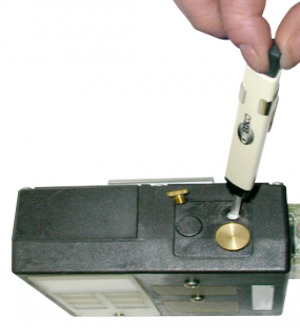Low Flow Sampling
From OSHKY Knowledge Library
Low flow sampling refers to the methods used to markedly reduce the air flow rate being pulled by a sampling pump that does not normally pull at such slow rates.
This page will detail how to achieve low flow rates using KYOSH's current equipment.
SKC AirChek 2000 & AirChek XR5000 Pumps
- The Constant Pressure Controller (CPC), otherwise known as the low flow adapter, should be connected to the pump by a length of Tygon tubing of about 1" to 1-1/2".
[Source: Constant Pressure Controller Operating Instructions]
- The pump flowrate should be set to approximately 1.5 L/min.
[Source: Constant Pressure Controller Operating Instructions] - The arrow on the charcoal tube indicates the direction of flow. Therefore, the arrow should always point toward the pump or, more precisely, the tube holder itself.
- If there is no arrow on the tube, look at the tube and determine the smallest section of media. This is the breakthrough area. Place it closest to the tube holder.
SKC Universal 224 Pumps
The 224 pumps have a built-in low flow feature. Do not add the CPC to the sampling train.
From the pump's manual:
- Start the pump using the on/off switch. Adjust the flow rate by turning the flow adjustment screw until the built-in rotameter reads approximately 1.5 L/min.
- Remove the cap screw covering the regulator valve and turn the exposed screw four to five turns counterclockwise. (Figure 1)
- Replace the cap screw. The pump is now set for low flow.
Tube Holders
Attaching Tube Holders to Employee
- Where these clip at the distal end of the tube protector, it is best to position the pump on the front or side of the employee, running the tube along the front of their shirt. (Figure 2) With cassette media, the cassette holders are clipped onto the employee in such a way that the Tygon tubing leads into it from above. This lends to the practice of running the tube from the employee's back, up, and over the shoulder to the cassette.
- Place the tube in such a way that it will remain vertical during the sampling. This helps to prevent a channeling effect, which may cause under-sampling.
- Channeling is the phenomenon created when, acting with gravity, the media settles to one side of the tube allowing the other side to form a more porous gap. Air would certainly rather flow through unimpeded than through the media.
Multiple Inlet Low Flow Tube Holders
- Do NOT close off unused inlets by screwing the valve closed. This can damage the valve seats.
- Instead, plug unused inlets with an unopened tube, whether you're calibrating or sampling.

